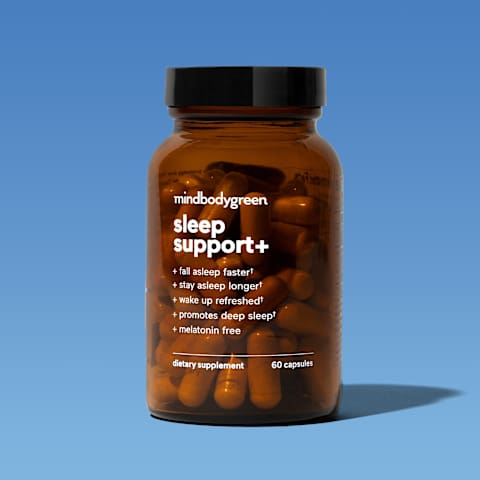Advertisement
I'm A Functional MD: My 4 Nonnegotiables For Sleeping Through The Night


We're likely not the first to tell you: Sleep is one of the most underrated elements of well-being. Think about how you feel after just a night of so-so rest—your whole system just feels off, no?
Functional medicine doctor Frank Lipman, M.D. (who recently penned a sleep-focused book titled Better Sleep, Better You), would agree: "Sleep is not a passive time," he said on a recent episode of the mindbodygreen podcast. "There's a ton of stuff happening while you're sleeping... It's not only cleansing your brain; it's cleansing your [whole] system. [Sleep] affects so many body processes."
In other words? Sleep fitness is an integral part of your well-being, just as crucial as your physical and mental fitness. But if you're a bit lacking in the snooze department (understandable; a report from the CDC found that 1 in 3 adults don't get enough sleep1), there's a lot you can do to set yourself up for sleep success—starting with your surroundings. Below, Lipman's top tips to optimize your sleep protocol:
Transition into bedtime.
"You can't expect to go at a hundred miles an hour and then drop and go to sleep," said Lipman. "There needs to be some transition period between your wake time and your sleep time."
Some transition activities include restorative yoga, relaxing music (a track with 60 beats per minute is especially helpful, as Lipman notes that's the beat of a slow heart rate), or even something as simple as dimming the lights. Find your method to wind down, and make it a routine so your mind registers that it's bedtime.
Strengthening your stress management routine will also pay off for sleep since lingering anxious thoughts from the day have a way of keeping people up at night. Try out a practice like journaling or just writing down your to-do list on a piece of paper to get stressful thoughts out of your head before you transition into bedtime. For a little extra help, a sleep-supporting supplement can be the cherry on top of a well-rounded wind-down routine.*
Stick to an electronic sundown.
As part of your bedtime transition period, Lipman suggests switching off electronics at least an hour or two before you go to sleep. If you're only going to follow one of these sleepytime protocols, this would be it. According to Lipman, "[Artificial light] is one of the biggest—if not the biggest—issue with cultural arrhythmia, or why so many people have a sleep problem."
He continues, "Melatonin, which is your primary sleep hormone, is not going to be secreted if there's any little bit of light." So if you're exposed to the haze of your computer or phone screen late at night, it could trick your body into thinking it's earlier than it is.
"By not letting all that blue light in, your body gets ready to start secreting the melatonin," Lipman adds.
Keep your room dark.
"Having a completely dark room is essential," he declares. Again, any peek of light can mess with your ability to get to bed on time. If you live in a bustling city, he suggests investing in some blackout curtains to keep your space dark. Or, at the very least, snag an eye mask: "The eye mask is a pretty simple way of darkening the room," he said.
And the temperature cool.
We've discussed this before, but it bears repeating: Sleep and temperature are inherently connected. As one study explains, "The core body temperature2...decreases during the nocturnal sleep phase and increases during the wake phase." That said? Keeping your room cool can help trick your body into feeling sleepy.
In terms of the best temperature for sleep, many experts tout 65 degrees Fahrenheit as the optimal setting. However, anything in the high 60s could work. According to Lipman, "67 [degrees] would probably be the warmest that I would recommend."
The takeaway.
Make no mistake: Your sleep hygiene is an imperative part of your overall health and well-being. Taking the time to create an optimal sleep routine is just as important as crafting, say, a fitness regimen. If you're looking for ways to level up your snooze, Lipman's pro tips are a great place to start.
